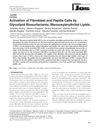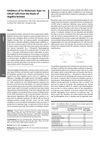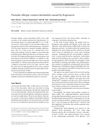
Search
for
Sort by
Research
330-360 / 1000+ results

research The Role of Vitamin D in Non-Scarring Alopecia
Low vitamin D might be linked to certain types of hair loss, and supplements could help, but more research is needed.

research Transepidermal UV Radiation of Scalp Skin Ex Vivo Induces Hair Follicle Damage That Is Alleviated by Topical Treatment with Caffeine
Caffeine applied to the scalp can protect hair follicles from UV damage.

research New Steps Forward in the Neuroactive Steroid Field
Neuroactive steroids could become safe, effective treatments with more understanding of their complex brain actions and metabolism.

research Activation of Fibroblast and Papilla Cells by Glycolipid Biosurfactants, Mannosylerythritol Lipids
MEL-A from soybean oil can boost fibroblast and papilla cells, potentially aiding hair growth.

research Microneedles Mediated Bioinspired Lipid Nanocarriers for Targeted Treatment of Alopecia
A new hair loss treatment uses tiny needles to deliver a drug-loaded lipid carrier, promoting hair growth more effectively than current treatments.

research Lupus Panniculitis Clinically Simulating Alopecia Areata
Lupus can look like hair loss from alopecia areata but needs different treatment.

research Changes in Distribution Pattern of CD8 Lymphocytes in the Scalp in Alopecia Areata During Treatment With Diphenylcyclopropenone
Diphencyprone treatment increases CD8 lymphocytes in the scalp, which is associated with hair regrowth in alopecia areata patients.

research The Promoting Effect of Ishige Sinicola on Hair Growth
Ishige sinicola, a type of seaweed, may help hair grow by blocking a hair loss-related enzyme and boosting important cell growth.

research Cutaneous Metabolism of Vitamin B-6
An enzyme other than TNAP might be responsible for vitamin B-6 metabolism in the skin.

research Hair Growth Activity of Crataegus Pinnatifida on C57BL/6 Mouse Model
Crataegus pinnatifida extract may help increase hair growth and thickness in mice.

research Safe Selection of Genetically Manipulated Human Primary Keratinocytes with Very High Growth Potential Using CD24
Researchers found a safe and effective way to pick genetically modified skin cells with high growth potential using CD24.

research Riboflavin-Responsive Glutaryl CoA Dehydrogenase Deficiency
Taking riboflavin and eating less lysine can help some people with a specific genetic disorder avoid brain damage.

research Runx1 Role in Epithelial and Cancer Cell Proliferation Implicates Lipid Metabolism and SCD1 and SOAT1 Activity
Runx1 controls fat-related genes important for normal and cancer cell growth, affecting skin and hair cell behavior.

research Comparisons of Mouse Models for Hair Follicle Reconstitution
The flap assay grows the most natural hair but takes the longest, the chamber assay is hard work but gives dense, normal hair, and the patch assay is quick but creates poorly oriented hair with some issues.

research Androgen Receptors Are Only Present in Mesenchyme-Derived Dermal Papilla Cells of Red Deer Neck Follicles When Raised Androgens Induce a Mane in the Breeding Season
Red deer only have androgen receptors in neck hair cells for mane growth during breeding season.

research Identification and Characterization of an Antisense RNA Transcript (GFG) from the Human Basic Fibroblast Growth Factor Gene
Researchers found an RNA transcript that might help control a growth factor linked to tumor development.

research Dihydrotestosterone-Induced Hair Regrowth Inhibition by Activating Androgen Receptor in C57BL6 Mice Simulates Androgenetic Alopecia
DHT stops hair regrowth in mice, similar to human hair loss.

research Injectable Platelet-Rich Fibrin: The Newest Biomaterial and Its Use in Various Dermatological Conditions in Our Practice: A Case Series
Injectable Platelet-Rich Fibrin (I-PRF) showed positive results for treating hair loss, skin texture, wrinkles, and wounds.

research Baicalin Increases Hair Follicle Development by Enhancing Canonical Wnt/β-Catenin Signaling and Activating Dermal Papilla Cells in Mice
Baicalin helps hair growth by activating specific cell signals and pathways.

research Inhibitors of 5α-Reductase Type I in LNCaP Cells from the Roots of Angelica Koreana
Compounds from Angelica koreana roots, especially osthenol, could be effective for treating conditions like prostate disease and hair loss.

research Investigation by Imaging Mass Spectrometry of Biomarker Candidates for Aging in the Hair Cortex
Certain molecules in hair change with age and could be used for cosmetic treatments.

research Human Placental Extract Exerts Hair Growth-Promoting Effects Through the GSK-3β Signaling Pathway in Human Dermal Papilla Cells
Human placental extract may help hair growth by affecting certain cell signals and could be more effective with minoxidil.

research Hair Matrix Cell Kinetics: A Selective Review
Hair growth is influenced by factors like genetics and nutrition, and more research is needed to understand hair loss and growth mechanisms.

research The Effect of Finasteride and Dutasteride on the Synthesis of Neurosteroids by Glioblastoma Cells
Finasteride and dutasteride reduce neurosteroid production, possibly helping treat glioblastoma.

research Dopamine Is a Novel, Direct Inducer of Catagen in Human Scalp Hair Follicles In Vitro
Dopamine stops hair growth and pigment production in human scalp hair follicles.

research Developing Formulations for Drug Follicular Targeting: Nanoemulsions Loaded with Minoxidil and Clove Oil
Nanoemulsions with minoxidil and clove oil effectively target hair follicles for better alopecia treatment.

research Pustular Allergic Contact Dermatitis Caused by Fragrances
Avoiding certain fragrances improved the man's skin condition.

research Stimulatory Effect of Brazilian Propolis on Hair Growth Through Proliferation of Keratinocytes in Mice
Brazilian propolis was found to speed up hair growth in mice by increasing the growth of skin cells that form hair.

research Distribution of Glycolipid and Unsaturated Fatty Acids in Human Hair
Human hair has more unsaturated fats inside than on the surface, and certain lipids may help bind the outer and inner layers together.